Results 1 to 10 of 185
Thread: Learning Jnats with Microscope
Hybrid View
-
03-31-2021, 02:15 PM #1Senior Member



- Join Date
- Apr 2012
- Location
- Diamond Bar, CA
- Posts
- 6,553
Thanked: 3215
I, by no means consider myself an expert on Jnats. I have only been experimenting with them for about 5-6 years.
My first foray into Jnats, a small Kita and Mikawa progression was not a big hit for me. It was only until I watched some of Alex Gilmores videos and he posted stone testing videos, where he set a bevel on a King 1k and finished the razor on diamond slurry. A simple 2 step process, Alex did not even bother to fully remove all the deep 1k stria but produced great shaving edges on a variety of vintage razors. Alex demonstrated how simple and basic honing on a Jnat could be. Up until then it just seemed so complicated and fussy.
I came from learning to hone a razor on a 6-inch translucent, talk about simple, water or a drop or two of oil and rub the razor on the stone. And produce a smoking edge. The Jnat is the only stone that could ever produce an edge that rivaled an Ark edge. Paste can come close but not as comfortable as a Jnat or Ark. I finish all razors on Arks or Jnats now.
Once Alex opened the door, I looked for photos of great Jnat edges. The best I have seen were from Alex Gilmore, Oz and Doc226. Those are the bevels and edges I try to emulate. But as I have said, how a bevel looks, does not guarantee a great edge, but it for me is a good indicator, if everything else is done right.
I probably have 10 or 12 Jnats and lots of tomo nagura, none of my stones are high dollar stones, most are Kopa or a bit larger, most are about $100 stones some $20-30, and the most expensive probably in the $250 range.
My favorites are a small Kita, hard Iromono Kita, Karasu Asagi. Large clean Asagi and a small Suita. Typically, I set the bevel on a 1k, usually a King and jump straight to the 8k, old crazed Naniwia Snow White.
From an 8k pristine bevel I use a Tsushima nagura to a Tenjyou and finish on a small hard Asagi or Koma nagura. All on the same base stone.
Keep it simple.
-
The Following User Says Thank You to Euclid440 For This Useful Post:
ischiapp (04-01-2021)
-
03-31-2021, 03:31 PM #2

Euclid
I forgot to ask you if the heel had to be modified... and however you answered me
Anyway yesterday I was careful not to let the stabilizer touch the stone. Also don't think it was the problem as I made a double bevel already on the first time... but didn't add tape to do it.
Also I don't think I applied too much pressure (being a 5/8" that blade is quite stiff, despite the fact it's a full hollow). Of course I can be wrong.
Probably at that point, the bevel was enlarged during the restoration.
Regarding this statement: "I, by no means consider myself an expert on Jnats. I have only been experimenting with them for about 5-6 years."
Well... it's just... 5-6 years more than me! I know that I don't know (Socrates)
I know that I don't know (Socrates)
-
04-01-2021, 07:13 PM #3
 Eight Round.
Eight Round.
After testing 7 different Naguras (plus Tsushima) I was really curios to see how the base stone (Nakayama Kiita Koppa) would work with a.... "Water Nagura"
 after the Tsushima.
after the Tsushima.
So today I tested it water only and under running water. I stopped each section when I felt that the blade was sliding with increasing difficulty on the stone because of the sticking effect. So, under running water I was able to make just very few strokes.
I am not skilled enough to properly evaluate the microscopic results (I just notice the darker part of the bevel, whick should means it's polished (?)) but, to get a better idea, I checked the bevel with a 40X Loupe too, and it appeared homogeneously shiny, with really very fine (almost invisible) sharpening marks.
BTW. the usual "reference point" I used until now (the edge chip) has been completely eliminated.
The blade passed easily finger & treetop test.
Shave test scheduled for tomorrow.
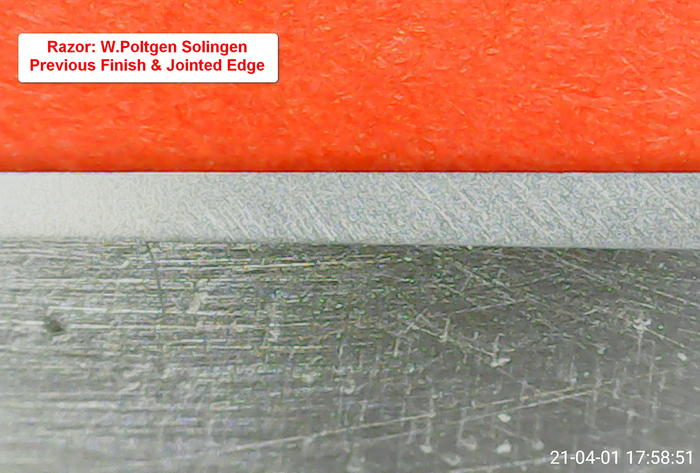

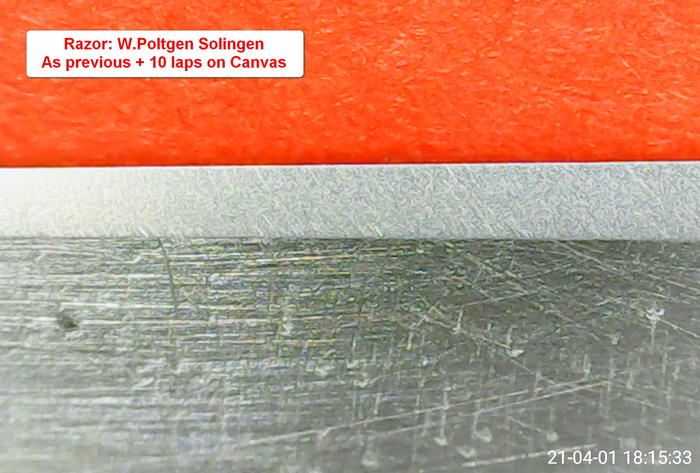
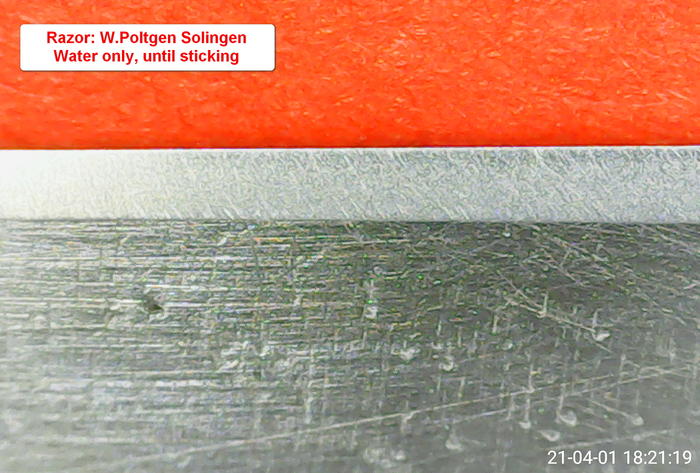
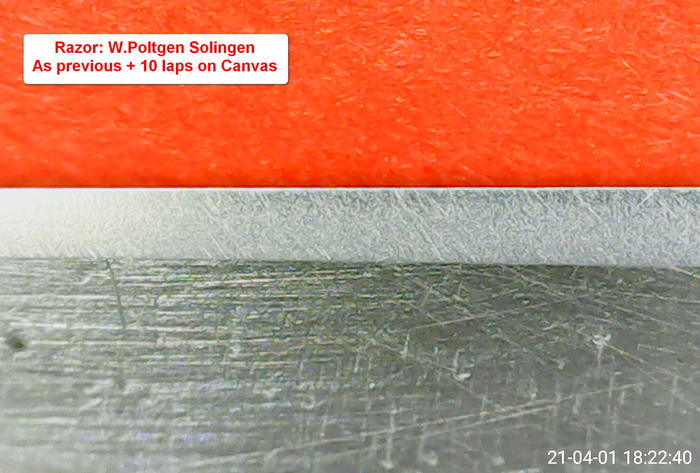
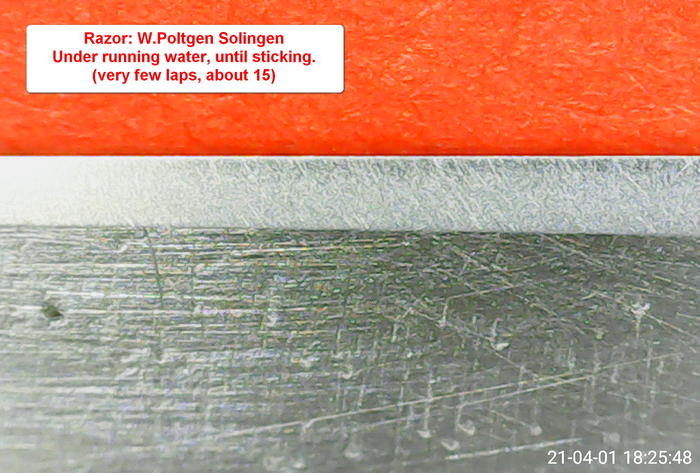
 I know that I don't know (Socrates)
I know that I don't know (Socrates)
-
04-02-2021, 02:25 PM #4Senior Member



- Join Date
- Apr 2012
- Location
- Diamond Bar, CA
- Posts
- 6,553
Thanked: 3215
Yes, that is typical of a water finish, with slight random scratches and a bit of a polished band near the edge. On an edge forward stroke the polish starts at the edge.
It looks good and not as scratchy as most I have done with water. Will be interesting to see how it shaves.
-
The Following User Says Thank You to Euclid440 For This Useful Post:
Skorpio58 (04-02-2021)
-
04-02-2021, 02:53 PM #5
 Comparative Test of Naguras - The Ranking!
Comparative Test of Naguras - The Ranking!
Yep,
after eight rounds of comparative tests of several Naguras it's time to draw some conclusions.
1) All the Naguras (with the same Razor, on the same base stone, used by the same guy, with the same procedures) gave more than accettable shaves. I dare say, very good ones!
2) The microscope (as discussed in many posts above) evidenced some differences in finesse between the naguras. But these differences weren't directly related with the outcome of the single shaves. E.g. an apparently coarser nagura, gave a better post shave.
3) I really wasn't able to notice any appreciable difference in closeness/keeness, and noticed only subtle differences on blade's smoothness while shaving and post shave skin's behavior.
4) Regarding the small differences I noticed, it is necessary to take into account the daily variability of the skin/beard conditions, in addition to the different conditioning/soothing effect of the different shaving soaps and after shaves that I used.
I apologize, but I didn't manage to use the same setup over and over again for many almost consecutive times.
5) The sensitivity of the skin and the hardness of the beard is obviously very dependent on the individual characteristics. For this reason, what I consider acceptable can, on the contrary, be considered unpleasant by others and ... vice versa.
Note: all shaves made on a two days growt.
Conclusions: I'm sure it's possible to get better shaves improving either my technique, or the base stone and/or getting other naguras but, I learned a lot of thinghs during this "marathon" to think about for the future, and the level of my sharpening skills/knowledge has certainly risen, and I'm happy about this!
A special thanks to Euclid440 and all the Guys who visited or commented this thread! Happy Easter to you all!

Last edited by Skorpio58; 04-02-2021 at 06:37 PM.
I know that I don't know (Socrates)
-
-
04-06-2021, 04:27 PM #6Senior Member



- Join Date
- Apr 2012
- Location
- Diamond Bar, CA
- Posts
- 6,553
Thanked: 3215
Folks that have studied Jnats say that most all Jnats contain the same or similar grit/grit size, and that the minerals and other things that make up the binders are what makes a stone perform as hard or soft, aggressive or polisher, it is how grit is released.
Your study has pretty much confirmed what they have been saying, there is very little difference in the ability to polish an edge. Yes a few outshine the rest but really a relatively small difference. Your result pretty much reflects what I have found as far as Tomo performance. Hard Suita and Asagi are my favorite finish polishers.
You can work a slurry and get an even different result, for example a Tsushima slurry can be worked, broken down to produce a fine finish, but it takes a bit of time and work.
Also, what must be kept in mind is that these are your results with your natural stones, other’s techniques and stones may produce different results, but I feel your results are pretty consistent and can provide or at least point a honer in the right direction in stone selection.
For those that have never done it, it is a lot of work and a PIA to do the test, photograph and document the process, and why we do not see a lot of it on this forum.
So, lots of good work, the photos and documentation will help folks transition to Jnats and pull back the curtain of mystery surrounding these stones. They are after all, just rocks.
-
The Following User Says Thank You to Euclid440 For This Useful Post:
Skorpio58 (04-07-2021)
-
04-07-2021, 07:38 AM #7

Euclid,
thanks for your conclusions. You made the point.
In fact, I believe the final results were almost the same mainly because of my limited technical skill. I.e. given a base stone & different naguras, the outcome is due to the op. ability to squeeze the maximum performance out of it. Of course, my technical ability gradually improves, repeating the same movements over and over again, learning how slurry behaves on a certain stone and (thanks to the microscope), understanding how certain procedures affect the bevel and the edge of a certain blade, but of course, this technique takes much longer to be assimilated and perfected to the maximum.
I agree, as a systematic approach is critical to learn and understand how Jnats behave. Yes, they are just rocks (as you said) but our newbie's approach is often limited by too little knowledge (and too much hype) about these stones. So, I'm happy If my work can be useful to anyone else who intends to approach them.
Next Step: I'm going to make the same comparative test on my Ozuku (Asagi?) as it gives me (when honing on it) a somewhat different feeling than the Nakayama Kiita. This does not necessarily mean that the results will be very different, but it is always better to check it rationally.
After these tests, maybe I'll be finally ready to learn HOW to work the slurry to enhance the performance of the single nagura/base stone pairing...
Last edited by Skorpio58; 04-07-2021 at 07:42 AM.
I know that I don't know (Socrates)
-
04-11-2021, 09:07 AM #8
 Second Comparative Nagura Test - Round One.
Second Comparative Nagura Test - Round One.
As I said in my previous post, Yesterday I started a new series of Naguras comparative tests: this time I used an Ozuku (asagi?) Koppa as base stone.
I changed the razor for this series, but also this one is a 6/8" FH Solingen.
The razor was previously honed by myself on a sinth 3/8K followed by diamond slurry on my Italian Curgèle stone (see some pages above) and finished on it water only. It shaved nicely (considering it was my third or fourth honing attempt )
)
First of all I had to make a new bevel because of some edge chips caused by a bad scales centering.
I did it also to see (following Euclid's suggestion) how the base stone performed by itself. So, after a King 1K I made 2 rounds of thick diamond slurry (5 mins. each) to see how the 1K stria were managed by the Ozuku's abrasive power itself.
Btw. the Eze Lap 1200G diamond plate raised quickly (about 20 seonds) a good amount of slurry(see photo)
Then I used the Black Tsushima Nagura (to set the test conditions as the previous series on Nakayama) followed by Nakayama Kiita (1) Tomo's Slurry.
It seems to me that the diamond slurry made a good work regarding the 1K stria... but I'm waiting for more authoritative judgments. The Nakayama Kiita (1) Tomo also seems to confirm not being one of the finer in my possession. I bet the edge could be straighter too.
Today's shave (as usual, WTG/ATG passes on a two days growth) performed very well in closeness and gave an excellent post shave. As on previous test, the general feeling during shaving was instead slightly below average.
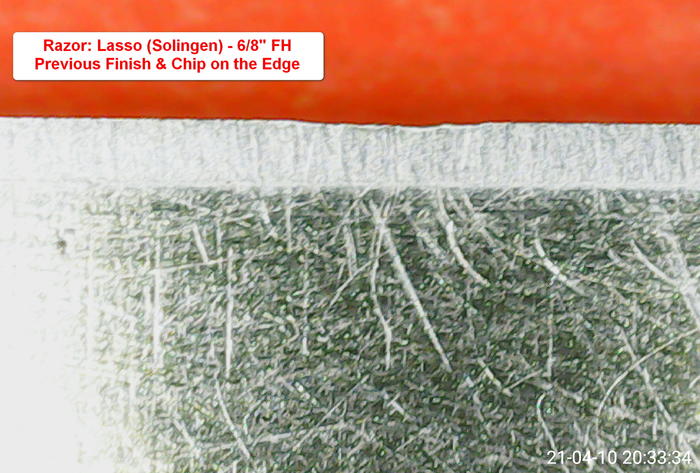
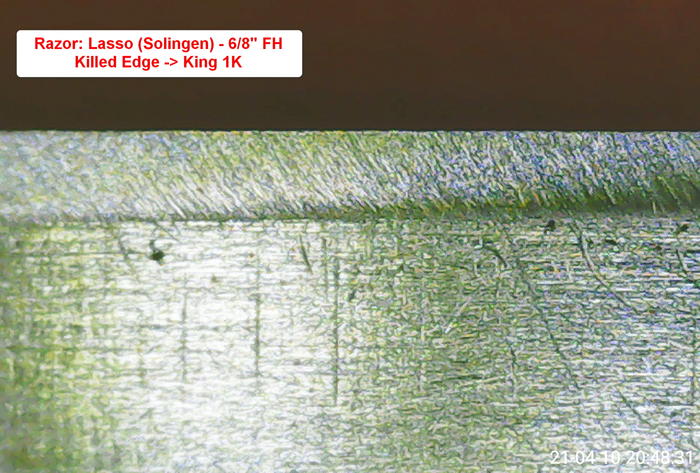
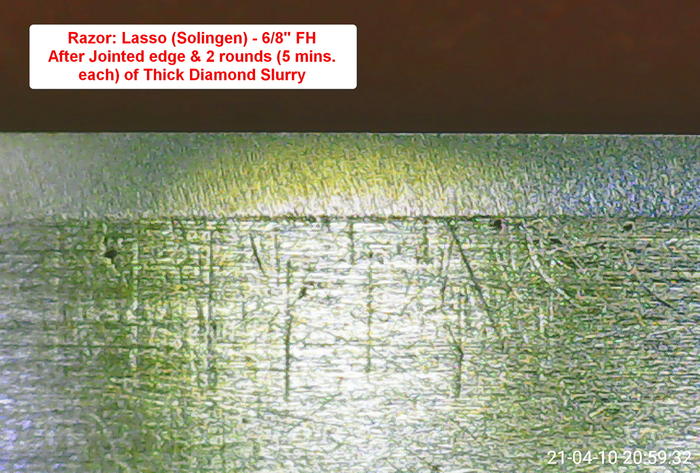
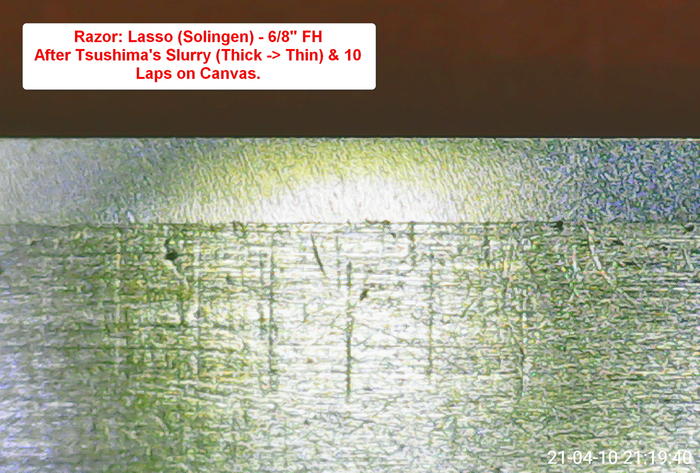
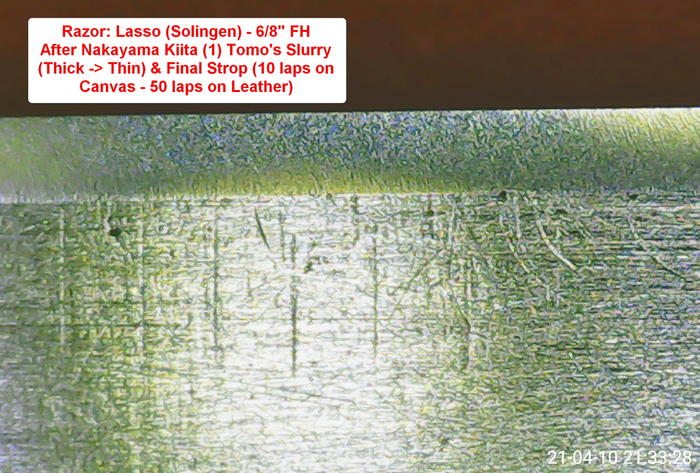
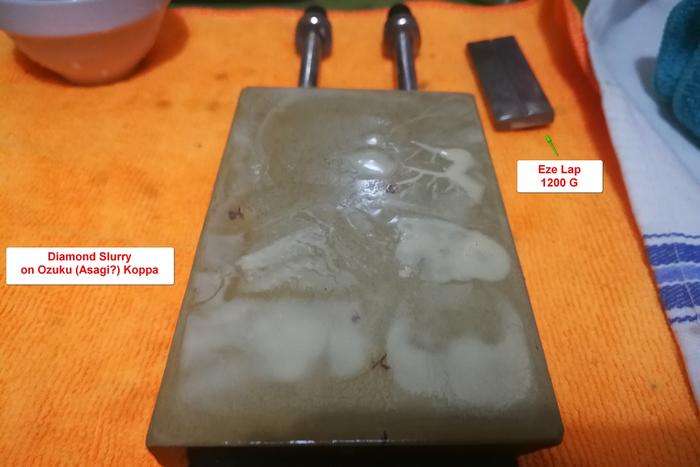
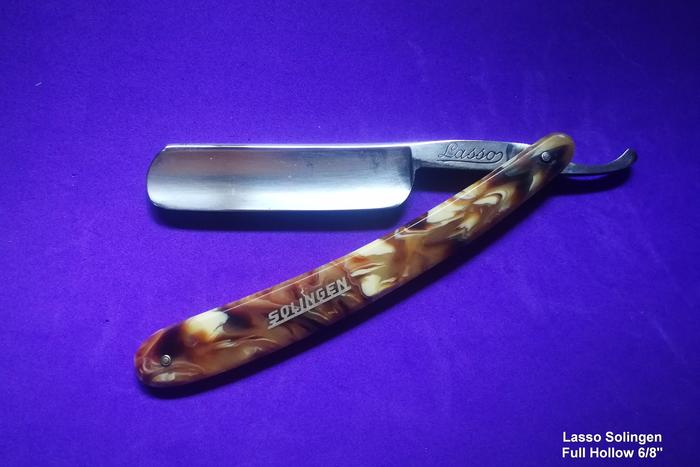
Last edited by Skorpio58; 04-11-2021 at 03:16 PM.
I know that I don't know (Socrates)


 211Likes
211Likes LinkBack URL
LinkBack URL About LinkBacks
About LinkBacks






 Reply With Quote
Reply With Quote
